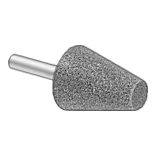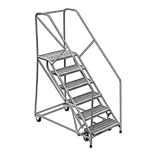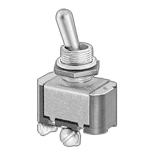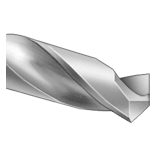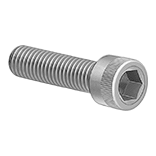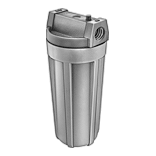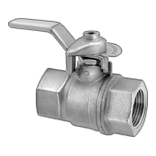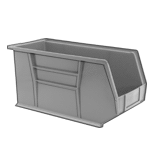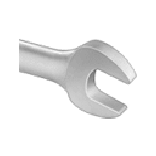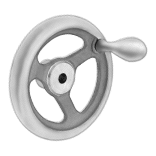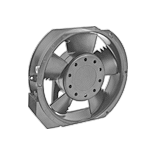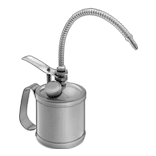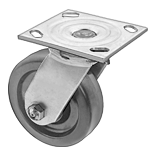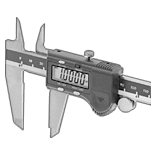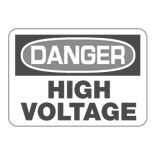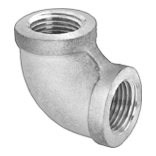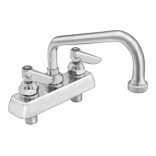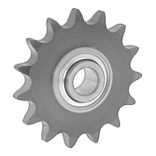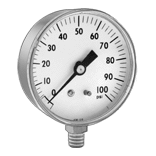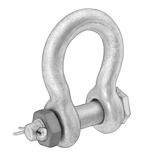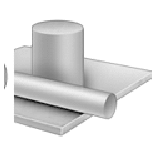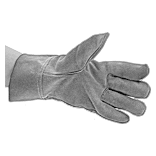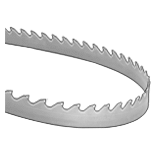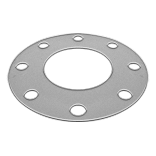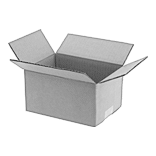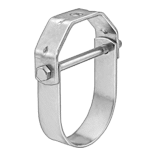Easy-to-Print PLA 3D Printer Filaments
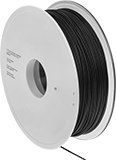
The most commonly used 3D printing material, these PLA filaments make detailed parts at a low melting point, so they won’t warp as they cool, rarely clog nozzles, and don’t require a heated printer bed. They’re also unlikely to drip and produce plastic strings for a clean finished part. In general, they’re best for printing prototypes instead of load-bearing parts since they’re not as strong as ABS or as heat resistant as PEEK. Print them on a fused filament fabrication (FFF) 3D printer.
Carbon fiber-filled PLA filaments make rigid parts that are difficult to bend and break. Their parts can also be threaded and machined more easily than the same non-filled filaments. Because these filaments are abrasive, you should only use them with abrasion-resistant nozzles.
Static-dissipative PLA filaments make parts that protect equipment from electrostatic shocks by diverting electrostatic discharges in a controlled way. They’re often used to create tool handles, tote trays, enclosures, and other parts that are used near sensitive electronics. To adjust the surface resistivity of your printed part, change the temperature of your printer’s extruder. As the extruder’s temperature increases, the printed part’s resistivity will decrease.
Conductive PLA filaments are best for creating circuit prototypes and other conductive pathways. To adjust the surface resistivity of your printed part, change the temperature of your printer’s extruder. As the extruder’s temperature increases, the printed part’s resistivity will decrease.
Expose parts made with glow-in-the-dark PLA filaments to ambient light and they will stay visible in the dark. Use these filaments to create machine switches and handles or custom signs and labels that can be seen in low-light conditions. Because they’re abrasive, you should only use them with abrasion-resistant nozzles.
Filaments with an annealing temperature can be heat treated to make parts harder, stronger, and better at resisting heat. To anneal, heat your finished part to the listed temperature and then let it cool slowly.
Tensile strength is the best measure of a filament’s overall strength. Similar to the stress applied on a rope during a game of tug-of-war, it’s the amount of pulling force a material can handle before breaking. A higher rating means a stronger filament. A tensile strength of 5,000 psi and above is considered good; 12,000 psi and above is excellent.
Maximum exposure temperature is the point at which a printed part will begin to deform. Above this temperature, your part will start to lose structural integrity. Filaments that can be annealed are also rated for maximum temperature after annealing, which is the new maximum exposure temperature once that process completes.
Spool | Each | ||||||||||||
|---|---|---|---|---|---|---|---|---|---|---|---|---|---|
| Dia., mm | Printing Temp. | For Printer Bed Temp. | Tensile Strength | Max. Exposure Temp. | Annealing Temp. | Max. Temp. After Annealing | For Min. Nozzle Dia., mm | Dia., mm | Dp., mm | Wt., g | 1-9 | 10-Up | |
PLA Plastic | |||||||||||||
Opaque Black | |||||||||||||
| 1.75 | 190° to 220° C 374° to 428° F | 25° to 60° C 77° to 140° F | 3,840 psi (Poor) | 59° C 138° F | __ | __ | 0.4 | 200 | 65 | 1,000 | 00000000 | 000000 | 000000 |
| 1.75 | 190° to 230° C 374° to 446° F | 0° to 70° C 32° to 158° F | 9,500 psi (Good) | 60° C 140° F | 110° to 120° C 230° to 248° F | 130° C 266° F | 0.4 | 200 | 91 | 1,000 | 00000000 | 00000 | 00000 |
| 2.85 | 190° to 230° C 374° to 446° F | 0° to 70° C 32° to 158° F | 9,500 psi (Good) | 60° C 140° F | 110° to 120° C 230° to 248° F | 130° C 266° F | 0.4 | 200 | 91 | 1,000 | 00000000 | 00000 | 00000 |
Carbon-Fiber-Filled PLA Plastic | |||||||||||||
Opaque Black | |||||||||||||
| 1.75 | 195° to 225° C 383° to 437° F | 21° to 60° C 70° to 140° F | Not Rated | 60° C 140° F | 100° to 120° C 212° to 248° F | 138° C 280° F | 0.4 | 200 | 50 | 500 | 0000000 | 00000 | 00000 |
| 1.75 | 195° to 225° C 383° to 437° F | 21° to 60° C 70° to 140° F | Not Rated | 60° C 140° F | 100° to 120° C 212° to 248° F | 138° C 280° F | 0.4 | 300 | 100 | 3,000 | 0000000 | 000000 | 000000 |
| 1.75 | 210° to 230° C 410° to 446° F | 21° to 60° C 70° to 140° F | Not Rated | 60° C 140° F | __ | __ | 0.4 | 200 | 50 | 500 | 0000000 | 00000 | 00000 |
| 1.75 | 210° to 230° C 410° to 446° F | 21° to 60° C 70° to 140° F | Not Rated | 60° C 140° F | __ | __ | 0.4 | 300 | 100 | 3,000 | 0000000 | 000000 | 000000 |
| 2.85 | 195° to 225° C 383° to 437° F | 21° to 60° C 70° to 140° F | Not Rated | 60° C 140° F | 100° to 120° C 212° to 248° F | 138° C 280° F | 0.4 | 200 | 50 | 500 | 0000000 | 00000 | 00000 |
| 2.85 | 210° to 230° C 410° to 446° F | 21° to 60° C 70° to 140° F | Not Rated | 60° C 140° F | __ | __ | 0.4 | 200 | 50 | 500 | 0000000 | 00000 | 00000 |
| 2.85 | 210° to 230° C 410° to 446° F | 21° to 60° C 70° to 140° F | Not Rated | 60° C 140° F | __ | __ | 0.4 | 300 | 100 | 3,000 | 0000000 | 000000 | 000000 |
Static-Dissipative PLA Plastic | |||||||||||||
Opaque Black | |||||||||||||
| 1.75 | 210° to 220° C 410° to 430° F | 23° to 60° C 73° to 140° F | 7,970 psi (Good) | 55° C 131° F | __ | __ | 0.25 | 200 | 70 | 750 | 0000000 | 000000 | 00000 |
| 2.85 | 210° to 220° C 410° to 430° F | 23° to 60° C 73° to 140° F | 7,970 psi (Good) | 55° C 131° F | __ | __ | 0.25 | 200 | 70 | 750 | 0000000 | 000000 | 00000 |
Conductive PLA Plastic | |||||||||||||
Opaque Black | |||||||||||||
| 1.75 | 195° to 225° C 383° to 437° F | 21° to 60° C 70° to 140° F | Not Rated | 60° C 140° F | __ | __ | 0.4 | 200 | 50 | 500 | 0000000 | 00000 | 00000 |
| 1.75 | 195° to 225° C 383° to 437° F | 21° to 60° C 70° to 140° F | Not Rated | 60° C 140° F | __ | __ | 0.4 | 300 | 100 | 2,000 | 0000000 | 000000 | 000000 |
| 2.85 | 195° to 225° C 383° to 437° F | 21° to 60° C 70° to 140° F | Not Rated | 60° C 140° F | __ | __ | 0.4 | 200 | 50 | 500 | 0000000 | 00000 | 00000 |
| 2.85 | 195° to 225° C 383° to 437° F | 21° to 60° C 70° to 140° F | Not Rated | 60° C 140° F | __ | __ | 0.4 | 300 | 100 | 2,000 | 0000000 | 000000 | 000000 |
Impact-Resistant ABS 3D Printer Filaments
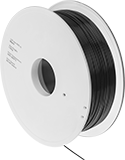 | |
Bumps, scrapes, and falls won’t damage these tough ABS filaments. Known for their durability, they absorb impact without cracking or breaking, and won’t degrade when heated. Use them to print tool handles, storage cases, and other parts that are handled or dropped frequently. These filaments are a good place to start if you’re experimenting with printing impact-resistant parts.
Use with a fused filament fabrication (FFF) 3D printer. These filaments have a high melting point and must be printed onto a heated bed. Without it, parts will cool too quickly and warp. These filaments also release fumes as they are printed, so use an enclosed printer or a fume exhauster to ventilate them.
SMA ABS filaments have a styrene additive that makes them easier to print and reduces warping during cooling. These filaments also form strong bonds between layers, so prints will not split apart. For heavy impact, use polycarbonate ABS filaments. The polycarbonate adds strength to printed parts.
Carbon-fiber-filled ABS filaments make rigid parts that are difficult to bend and break. Their parts can also be threaded and machined more easily than ABS filaments without a filler. Fiberglass-filled ABS filaments make parts that are stronger and less likely to warp or shrink than ABS filaments without a filler. Carbon-fiber- and fiberglass-filled filaments are abrasive, so you should use them with an abrasion-resistant nozzle. They will wear out other nozzles.
Static-dissipative filaments make parts that protect equipment from electrostatic shocks by diverting electrostatic discharges in a controlled way. Use them to create tool handles, tote trays, enclosures, and other parts that are used near sensitive electronics. To adjust the surface resistivity of your printed part, change the temperature of your printer’s extruder. As the extruder’s temperature increases, the printed part’s resistivity will decrease.
Filaments rated UL 94 V-0 meet strict flammability standards. Use them to create holders, guards, housings, and other parts that protect sensitive, flammable equipment and machinery.
Tensile strength is the best measure of a filament's overall strength. Similar to the stress applied on a rope during a game of tug-of-war, it's the amount of pulling force a material can handle before breaking. A higher rating means a stronger filament. A tensile strength of 5,000 psi and above is considered good; 12,000 psi and above is excellent.
Maximum exposure temperature is the point at which a printed part will begin to deform. Above this temperature, your printed parts will start to lose structural integrity.
Spool | ||||||||||||
|---|---|---|---|---|---|---|---|---|---|---|---|---|
| Dia., mm | Printing Temp. | For Printer Bed Temp. | Tensile Strength | Surface Resistivity, ohms/sq. | Max. Exposure Temp. | For Min. Nozzle Dia., mm | Dia., mm | Dp., mm | Wt., g | Color | Each | |
ABS Plastic | ||||||||||||
| 1.75 | 220° to 240° C 428° to 464° F | 100° to 110° C 212° to 230° F | 6,090 psi (Good) | __ | 90° C 194° F | 0.25 | 195 | 75 | 1,000 | Black | 00000000 | 000000 |
| 2.85 | 220° to 240° C 428° to 464° F | 100° to 110° C 212° to 230° F | 6,090 psi (Good) | __ | 90° C 194° F | 0.25 | 195 | 75 | 1,000 | Black | 00000000 | 00000 |
SMA ABS Plastic | ||||||||||||
| 1.75 | 240° to 260° C 464° to 500° F | 100° to 120° C 212° to 248° F | 4,300 psi (Poor) | __ | 71° C 160° F | 0.4 | 200 | 55 | 750 | Black | 00000000 | 00000 |
| 2.85 | 240° to 260° C 464° to 500° F | 100° to 120° C 212° to 248° F | 4,300 psi (Poor) | __ | 71° C 160° F | 0.4 | 200 | 55 | 750 | Black | 00000000 | 00000 |
Carbon-Fiber-Filled ABS Plastic | ||||||||||||
| 1.75 | 220° to 240° C 428° to 464° F | 100° to 110° C 212° to 230° F | 6,670 psi (Good) | __ | 76° C 169° F | 0.4 | 195 | 55 | 750 | Black | 00000000 | 00000 |
| 2.85 | 220° to 240° C 428° to 464° F | 100° to 110° C 212° to 230° F | 6,670 psi (Good) | __ | 76° C 169° F | 0.4 | 195 | 55 | 750 | Black | 00000000 | 00000 |
Fiberglass-Filled ABS Plastic | ||||||||||||
| 1.75 | 230° to 245° C 446° to 473° F | 95° to 110° C 203° to 230° F | 9,862 psi (Good) | __ | 89° C 192° F | 0.4 | 198 | 62 | 750 | Black | 00000000 | 00000 |
ABS Plastic—Static-Dissipative | ||||||||||||
| 1.75 | 220° to 240° C 428° to 464° F | 100° to 110° C 212° to 230° F | 8,410 psi (Good) | 107-109 | 97° C 207° F | 0.4 | 200 | 75 | 750 | Black | 0000000 | 000000 |
| 2.85 | 220° to 240° C 428° to 464° F | 100° to 110° C 212° to 230° F | 8,410 psi (Good) | 107-109 | 97° C 207° F | 0.4 | 200 | 75 | 750 | Black | 0000000 | 000000 |
ABS Plastic—UL 94 V-0 | ||||||||||||
| 1.75 | 220° to 240° C 428° to 464° F | 100° to 110° C 212° to 230° F | 6,520 psi (Good) | __ | 95° C 203° F | 0.4 | 200 | 75 | 750 | Black | 00000000 | 00000 |
| 2.85 | 220° to 240° C 428° to 464° F | 100° to 110° C 212° to 230° F | 6,520 psi (Good) | __ | 95° C 203° F | 0.4 | 200 | 75 | 750 | Black | 00000000 | 00000 |
Polycarbonate ABS Plastic—UL 94 V-0 | ||||||||||||
| 1.75 | 265° to 285° C 509° to 545° F | 110° to 120° C 230° to 248° F | 8,700 psi (Good) | __ | 125° C 257° F | 0.4 | 200 | 75 | 750 | Black | 0000000 | 00000 |
High-Strength Impact-Resistant Polycarbonate 3D Printer Filaments

Create strong, durable parts that carry heavy loads and absorb blows and other impact without cracking or breaking. Made of polycarbonate, these filaments are stronger and resist heat better than other impact-resistant filaments, such as those made from ABS or ASA.
Use with a fused filament fabrication (FFF) 3D printer. These filaments have a high melting point and must be printed onto a heated bed. Without it, parts will cool too quickly and warp. These filaments also release fumes as they are printed, so use an enclosed printer or a fume exhauster to ventilate them.
Carbon-fiber-filled polycarbonate filaments make rigid parts that are difficult to bend and break. Parts made from these filaments can also be threaded and machined more easily than parts made from polycarbonate filaments without a filler. Fiberglass-filled polycarbonate filaments make parts that are less likely to warp or shrink than parts made from polycarbonate filaments without a filler. Both carbon-fiber- and fiberglass-filled filaments are abrasive, so you should use them with an abrasion-resistant nozzle.
Static-dissipative filaments make parts that protect equipment from electrostatic shocks by diverting electrostatic discharges in a controlled way. Use them to create tool handles, tote trays, enclosures, and other parts that are used near sensitive electronics. To adjust the surface resistivity of your printed part, change the temperature of your printer’s extruder. As the extruder’s temperature increases, the printed part’s resistivity will decrease.
UL 94 V-0 rated filaments meet strict flammability standards. Use them to create holders, guards, housings, and other parts that protect sensitive, flammable equipment and machinery.
Tensile strength is the best measure of a filament's overall strength. Similar to the stress applied on a rope during a game of tug-of-war, it's the amount of pulling force a material can handle before breaking. A higher rating means a stronger filament. A tensile strength of 5,000 psi and above is considered good; 12,000 psi and above is excellent.
Maximum exposure temperature is the point at which a printed part will begin to deform. Above this temperature, your printed parts will start to lose structural integrity.
Spool | |||||||||||||
|---|---|---|---|---|---|---|---|---|---|---|---|---|---|
| Dia., mm | Printing Temp. | For Printer Bed Temp. | Tensile Strength | Surface Resistivity, ohms/sq. | Hardness | Max. Exposure Temp. | For Min. Nozzle Opening Dia., mm | Dia., mm | Dp., mm | Wt., g | Color | Each | |
Polycarbonate Plastic | |||||||||||||
| 1.75 | 280° to 310° C 536° to 590° F | 110° to 120° C 230° to 248° F | 8,990 psi (Good) | __ | Durometer 84D (Hard) | 135° C 275° F | 0.4 | 195 | 40 | 500 | Black | 00000000 | 000000 |
Carbon-Fiber-Filled Polycarbonate Plastic | |||||||||||||
| 1.75 | 260° to 280° C 500° to 535° F | 80° to 100° C 175° to 210° F | 10,580 psi (Good) | __ | Not Rated | 115° C 245° F | 0.4 | 195 | 55 | 750 | Black | 00000000 | 00000 |
| 2.85 | 260° to 280° C 500° to 535° F | 80° to 100° C 175° to 210° F | 10,580 psi (Good) | __ | Not Rated | 115° C 245° F | 0.4 | 195 | 55 | 750 | Black | 00000000 | 00000 |
Polycarbonate Plastic—Static-Dissipative | |||||||||||||
| 1.75 | 260° to 300° C 500° to 572° F | 110° to 120° C 230° to 248° F | 9,860 psi (Good) | 107-109 | Rockwell R125 (Hard) | 135° C 275° F | 0.4 | 200 | 75 | 750 | Black | 0000000 | 000000 |
Fiberglass-Filled Polycarbonate Plastic—UL 94 V-0 | |||||||||||||
| 1.75 | 280° to 330° C 536° to 626° F | 80° to 100° C 176° to 212° F | 5,300 psi (Good) | __ | Not Rated | 124° C 255° F | 0.6 | 200 | 55 | 700 | Black | 0000000 | 00000 |
| 2.85 | 280° to 330° C 536° to 626° F | 80° to 100° C 176° to 212° F | 5,300 psi (Good) | __ | Not Rated | 124° C 255° F | 0.6 | 200 | 55 | 700 | Black | 0000000 | 00000 |
UV- and Impact-Resistant ASA 3D Printer Filaments
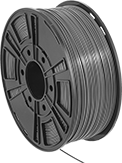 | ||
Best for outdoor use, parts made from these ASA filaments are UV resistant, so they won't warp or crack from prolonged sun exposure. They’re also durable, so they absorb impact without breaking and won’t degrade when heated.
Use with fused filament fabrication (FFF) 3D printer. These filaments have a high melting point and must be printed onto a heated bed. Without it, parts will cool too quickly and warp. These filaments also release fumes as they are printed, so use an enclosed printer or a fume exhauster to ventilate them.
Tensile strength is the best measure of a filament's overall strength. Similar to the stress applied on a rope during a game of tug-of-war, it's the amount of pulling force a material can handle before breaking. A higher rating means a stronger filament. A tensile strength of 5,000 psi and above is considered good; 12,000 psi and above is excellent.
Maximum exposure temperature is the point at which a printed part will begin to deform. Above this temperature, your printed parts will start to lose structural integrity.
Spool | |||||||||||
|---|---|---|---|---|---|---|---|---|---|---|---|
| Dia., mm | Printing Temp. | For Printer Bed Temp. | Tensile Strength | Max. Exposure Temp. | For Min. Nozzle Opening Dia., mm | Dia., mm | Dp., mm | Wt., g | Color | Each | |
ASA Plastic | |||||||||||
| 1.75 | 235° to 255° C 455° to 491° F | 90° to 110° C 194° to 230° F | 6,520 psi (Good) | 95° C 203° F | 0.4 | 200 | 75 | 1,000 | Black | 00000000 | 000000 |
| 2.85 | 235° to 255° C 455° to 491° F | 90° to 110° C 194° to 230° F | 6,520 psi (Good) | 87° C 188° F | 0.4 | 198 | 78 | 1,000 | Black | 00000000 | 00000 |
Wear-Resistant Nylon 3D Printer Filaments
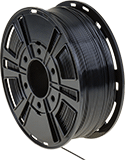
Print tough, long-lasting parts that won’t scratch or wear out from constant motion and friction, such as gears and washers. You can even tap or drill the parts without them cracking or shattering.
Use these filaments with fused filament fabrication (FFF) printers. Because of their relatively high melting point, a heated printer bed is recommended. These filaments also emit fumes when printing, so it’s best to use them in an enclosed printer or to remove the fumes with a fume exhauster. Store them in a sealed container with a desiccant so they don’t absorb moisture in the air, which can make them unusable.
Nylon 6/66 filaments are the strongest nylon filaments without a filler, but may warp while cooling.
Nylon 6/69 filaments stand up to chemicals for use in a variety of chemical processing applications. They’re also FDA Compliant 21 CFR 177.1395 and FDA Compliant 21 CFR 177.1500, so they can be used to produce parts that are intended for processing, handling, and packaging food and beverages.
Carbon-fiber-filled nylon filaments make rigid parts that are difficult to bend and break. Their parts can also be threaded and machined more easily than the same filaments without any filler. However, they’re abrasive, so only use them with abrasion-resistant nozzles.
Tensile strength is the best measure of a filament's overall strength. Similar to the stress applied on a rope during a game of tug-of-war, it's the amount of pulling force a material can handle before breaking. A higher rating means a stronger filament. A tensile strength of 5,000 psi and above is considered good; 12,000 psi and above is excellent.
Maximum exposure temperature is the point at which a printed part will begin to deform. Above this temperature, your printed parts will start to lose structural integrity.
Spool | ||||||||||||
|---|---|---|---|---|---|---|---|---|---|---|---|---|
| Dia., mm | Printing Temp. | For Printer Bed Temp. | Tensile Strength | Hardness | Max. Exposure Temp. | Specifications Met | For Min. Nozzle Opening Dia., mm | Dia., mm | Dp., mm | Wt., g | Each | |
Nylon Plastic 6/66 | ||||||||||||
Black | ||||||||||||
| 1.75 | 255° to 275° C 491° to 527° F | 60° to 70° C 140° to 158° F | 8,700 psi (Good) | Durometer 60D (Medium) | 85° C 185° F | __ | 0.25 | 200 | 75 | 750 | 000000 | 000000 |
Nylon Plastic 6/69 | ||||||||||||
Black | ||||||||||||
| 2.85 | 250° to 255° C 482° to 491° F | 30° to 65° C 86° to 149° F | 8,100 psi (Good) | Not Rated | 82° C 180° F | FDA Compliant 21 CFR 177.1395, FDA Compliant 21 CFR 177.1500 | 0.2 | 200 | 70 | 1,000 | 0000000 | 00000 |
Carbon Fiber-Filled Nylon Plastic | ||||||||||||
Black | ||||||||||||
| 1.75 | 280° to 300° C 535° to 570° F | 50° C 122° F | 15,225 psi (Excellent) | Not Rated | 125° C 257° F | __ | 0.4 | 200 | 65 | 500 | 000000 | 00000 |
Flexible TPU 3D Printer Filaments
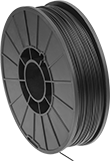 | ||||
Stretchy, soft, and sturdy, these filaments make durable parts that resist breakage despite repeated use. Stronger than ABS and PLA filaments, they create long-lasting parts, such as seals, sleeves, and gaskets, as well as components that take on high-impact forces, such as springs and snap-fit parts. These filaments don't require a heated printer bed, and they won't shrink or warp when cooling. Use them with a fused filament fabrication (FFF) 3D printer. In general, these flexible filaments require a slow feed rate so they don't jam. The softer your filament, the slower your feed rate will need to be. Store them in a sealed container with a desiccant, or use a dehumidifying cabinet, since ambient humidity will cause the plastic to degrade and weaken.
Conductive filaments can be used to create circuit prototypes and other conductive pathways. You can adjust the surface resistivity by changing the temperature of your printer's extruder. As the extruder’s temperature increases, the printed part’s resistivity will decrease.
For the most flexible parts, use durometer 85A filaments. They're more flexible than other TPU filaments. For a quick print without sacrificing flexibility, choose durometer 95A filaments. They print much faster than other TPU filaments.
Tensile strength is the best measure of a filament's overall strength. Similar to the stress applied on a rope during a game of tug-of-war, it's the amount of pulling force a material can handle before breaking. A higher rating means a stronger filament. A tensile strength of 5,000 psi and above is considered good; 12,000 psi and above is excellent.
Maximum exposure temperature is the point at which a printed part will begin to deform. Above this temperature, your printed parts will start to lose structural integrity.
Spool | ||||||||||||
|---|---|---|---|---|---|---|---|---|---|---|---|---|
| Dia., mm | Printing Temp. | For Printer Bed Temp. | Tensile Strength | Surface Resistivity | Max. Exposure Temp. | For Min. Nozzle Opening Dia., mm | Dia., mm | Dp., mm | Wt., g | Color | Each | |
TPU Plastic—Durometer 85A (Medium Soft) | ||||||||||||
| 1.75 | 225° to 235° C 437° to 455° F | 21° to 40° C 70° to 104° F | 580 psi | __ | 44° C 111° F | 0.25 | 200 | 70 | 1,000 | Opaque Black | 00000000 | 000000 |
| 2.85 | 225° to 235° C 437° to 455° F | 21° to 40° C 70° to 104° F | 580 psi | __ | 44° C 111° F | 0.25 | 200 | 70 | 1,000 | Opaque Black | 00000000 | 00000 |
TPU Plastic—Durometer 95A (Medium Soft) | ||||||||||||
| 1.75 | 230° to 240° C 446° to 464° F | 21° to 40° C 70° to 104° F | 1,250 psi | __ | 49° C 120° F | 0.25 | 200 | 70 | 1,000 | Opaque Black | 00000000 | 00000 |
| 2.85 | 230° to 240° C 446° to 464° F | 21° to 40° C 70° to 104° F | 1,250 psi | __ | 49° C 120° F | 0.25 | 200 | 70 | 1,000 | Opaque Black | 00000000 | 00000 |
Conductive TPU Plastic—Durometer 90A (Medium Soft) | ||||||||||||
| 1.75 | 220° to 230° C 428° to 446° F | 45° C 113° F | 1,700 psi | 1.5 × 103 ohms-cm | Not Rated | 0.4 | 200 | 50 | 1,000 | Opaque Black | 0000000 | 000000 |
| 2.85 | 220° to 230° C 428° to 446° F | 45° C 113° F | 1,700 psi | 1.5 × 103 ohms-cm | Not Rated | 0.4 | 200 | 50 | 1,000 | Opaque Black | 0000000 | 000000 |
Moisture-Resistant Polyester 3D Printer Filaments
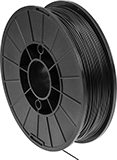
Parts printed with these polyester filaments absorb less moisture than other types of plastic, making them ideal for use in wet or humid environments. They are more durable and flexible than PLA, and easier to print than ABS. Use these filaments with fused filament fabrication (FFF) 3D printers, and print onto a heated print bed. Printing onto a cool surface causes the molten filament to change temperature rapidly, which can warp your designs. Although finished parts are moisture-resistant, these filaments are sensitive to humidity, and should be stored in a dehumidifying cabinet or a sealed container with desiccant for the best printing quality.
PETG contains glycol, so it is less brittle and easier to print than PETT and PCTG. Carbon-fiber-filled PETG is often used to make rigid parts that are difficult to bend and break. Finished parts are easier to thread and machine than unfilled parts. Because these filaments are abrasive, use them only with abrasion-resistant nozzles.
Static-dissipative filaments make parts that protect equipment from electrostatic shocks by diverting electrostatic discharges in a controlled way. Create tool handles, tote trays, enclosures, and other parts that are used near sensitive electronics. To adjust the surface resistivity of your printed part, change the temperature of your printer’s extruder. As the extruder’s temperature increases, the printed part’s resistivity will decrease.
Antistatic filaments make parts that prevent the buildup of static electricity. This helps prevent the buildup of dust or fibers on the surface of your finished part. However, they are not as effective at preventing electrostatic discharge as static-dissipative filaments.
Tensile strength is the best measure of a filament's overall strength. Similar to the stress applied on a rope during a game of tug-of-war, it's the amount of pulling force a material can handle before breaking. A higher rating means a stronger filament. A tensile strength of 5,000 psi and above is considered good; 12,000 psi and above is excellent.
Maximum exposure temperature is the point at which a printed part will begin to deform. Above this temperature, your printed parts will start to lose structural integrity.
Spool | ||||||||||||
|---|---|---|---|---|---|---|---|---|---|---|---|---|
| Dia., mm | Printing Temp. | For Printer Bed Temp. | Tensile Strength | Hardness | Surface Resistivity, ohms/sq. | Max. Exposure Temp. | For Min. Nozzle Opening Dia., mm | Dia., mm | Dp., mm | Wt., g | Each | |
PETG Plastic—Static Dissipative | ||||||||||||
Opaque Black | ||||||||||||
| 1.75 | 230° to 260° C 446° to 500° F | 60° to 90° C 140° to 194° F | 7,250 psi (Good) | Rockwell R110 (Hard) | 107-109 | 75° C 167° F | 0.4 | 200 | 75 | 750 | 0000000 | 0000000 |
| 2.85 | 230° to 260° C 446° to 500° F | 60° to 90° C 140° to 194° F | 7,250 psi (Good) | Rockwell R110 (Hard) | 107-109 | 75° C 167° F | 0.4 | 200 | 75 | 750 | 0000000 | 000000 |
Carbon-Fiber-Filled PETG Plastic—Antistatic | ||||||||||||
Opaque Black | ||||||||||||
| 1.75 | 230° to 260° C 446° to 500° F | 60° C 140° F | 8,120 psi (Good) | Not Rated | 109-1012 | 77° C 170° F | 0.4 | 200 | 60 | 750 | 000000 | 00000 |
| 2.85 | 230° to 260° C 446° to 500° F | 60° C 140° F | 8,120 psi (Good) | Not Rated | 109-1012 | 77° C 170° F | 0.4 | 200 | 60 | 750 | 0000000 | 00000 |
Dremel 3D Printer Filaments
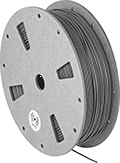
Build parts and prototypes from these filaments using Dremel fused filament fabrication (FFF) 3D printers. An RFID tag on the spool communicates with your printer, automatically adjusting it to the correct temperature and print speed for the filament material and notifying you when the filament is running out.
PLA filaments are the most commonly used in 3D printing. PLA is easy to use; it rarely clogs nozzles, doesn’t require a heated printer bed, and prints at a low temperature—meaning parts won’t warp while cooling. It produces string-free parts, so you can use it to print with a high level of detail. Less durable and more sensitive to heat than ECO-ABS, PLA is better for printing prototypes than end-use parts.
ECO-ABS is less brittle and more impact resistant than PLA, so these filaments are good for printing parts that are frequently handled, dropped, or heated. They are, however, a little more high maintenance—parts may warp during cooling, so they require a heated printer bed.
Nylon resists scratches and wear, and is often used to create parts that encounter constant friction such as gears or bearings. Nylon parts also won’t crack or shatter when they’re drilled or tapped. Exposure to humidity makes these filaments brittle and unusable, so they need to be stored in a sealed container with a desiccant. Like ECO-ABS, parts can warp during cooling and need a heated printer bed. Make sure your printer is connected to a ventilation system, as nylon emits fumes during printing.
Tensile strength is the best measure of a filament's overall strength. Similar to the stress applied on a rope during a game of tug-of-war, it's the amount of pulling force a material can handle before breaking. A higher rating means a stronger filament. A tensile strength of 5,000 psi and above is considered good; 12,000 psi and above is excellent.
Maximum exposure temperature is the point at which a printed part will begin to deform. Above this temperature, your printed parts will start to lose structural integrity.
Spool | ||||||||||||
|---|---|---|---|---|---|---|---|---|---|---|---|---|
| Manufacturer Model No. | Dia., mm | Printing Temp. | For Printer Bed Temp. | Tensile Strength | Max. Exposure Temp. | For Min. Nozzle Opening Dia., mm | Dia., mm | Dp., mm | Wt., g | Color | Each | |
PLA Plastic | ||||||||||||
| __ | 1.75 | 200° to 230° C 395° to 445° F | 35° C 95° F | 6,620 psi (Good) | 60° C 140° F | 0.25 | 180 | 55 | 750 | Black | 000000 | 000000 |
ECO-ABS Plastic | ||||||||||||
| ECO-BLA-01 | 1.75 | 190° to 240° C 374° to 464° F | 60° C 140° F | 8,410 psi (Good) | 63° C 145° F | 0.2 | 181 | 55 | 750 | Black | 0000000 | 00000 |
Nylon Plastic | ||||||||||||
| DF45-NYP-B | 1.75 | 230° to 250° C 446° to 482° F | 80° C 176° F | 7,540 psi (Good) | 155° C 311° F | 0.4 | 180 | 55 | 500 | Black | 0000000 | 00000 |
MakerBot 3D Printer Filaments
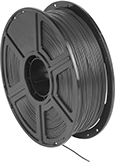
Compatible with the MakerBot Replicator 2 Desktop 3D Printer, all Fifth Generation MakerBot Replicator 3D printers, and Sketch printers. Product regulations restrict sales to the listed jurisdictions/areas.
Spool | |||||||||
|---|---|---|---|---|---|---|---|---|---|
| Material | Color | Dia., mm | Wt. | Manufacturer Model Number | Dia. | Dp. | Cannot Be Sold To | Each | |
For Manufacturer Series: Fifth Generation Replicator, Replicator 2 | |||||||||
| PLA | Black | 1.75 | 900 g | MP05775 | 9 3/4" | 1 1/2" | __ | 0000000 | 000000 |
For Manufacturer Series: Sketch | |||||||||
| PLA | Black | 1.75 | 2.2 lbs. | 375-0048A | 8" | __ | Outside United States and Canada | 0000000 | 00000 |
